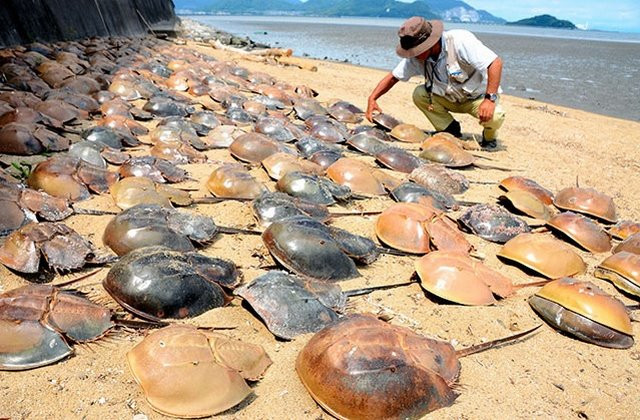500 samsara died abnormally on the Japanese coast
Nearly 500 samsara died on collective death on the beaches near Kitakyushu in southern Japan, causing experts to be confused.
Conservationists discovered 10 pups, also known as horseshoe crabs , died on Japanese beaches, 8 times higher than normal, Asahi Shimbun reported on September 14. Every year, these animals often swim tidal to the west and south beaches to lay eggs.

Sam died covering the Japanese beach.(Photo: Takuya Miyano).
Many experts believe that the phenomenon of collective dead sea sam is a consequence of global warming , lack of egg laying and disease. Some researchers speculate that the species can lay fewer eggs in the next year.
Sea Sam is not crab. They have them close to spiders and scorpions. They are on the list of endangered species in Japan due to destroyed habitats.
Sam sea is one of the oldest creatures in the world and extremely precious due to the blue blood . One liter of sea salt costs $ 15,000.
Scientists have been collecting sea-salt blood since the 1970s to check the sterility of medical devices and drugs administered intravenously. The blood has the effect of coagulating small amounts of bacteria and causing immobilizing pathogens.
- Whales on the Thai coast died of swallowing many nylon bags
- Nishimura Masanari - a very Vietnamese Japanese
- Japanese encephalitis on the top of the epidemic
- Japanese archaeologists died in Vietnam
- Japanese radiation detection off the west coast of the United States
- 136 dolphin trapped, dead carpet on the West African coast of unknown cause
- Tsunami in 2011 brought millions of creatures from Japan to the US coast
- 'Ghost boat' carrying mutant suspects washed up on the coast of Hawaii
- The Japanese coast sparkles in the night
- The Japanese island suddenly disappears, looking forever and unseen
- Glowing sea shrimp glows on the coast of Japan
- Video: Desperate effort to save 416 whales from drifting to the coast of New Zealand
 Surprised: Fish that live in the dark ocean still see colors
Surprised: Fish that live in the dark ocean still see colors Japan suddenly caught the creature that caused the earthquake in the legend
Japan suddenly caught the creature that caused the earthquake in the legend A series of gray whale carcasses washed ashore on California's coast
A series of gray whale carcasses washed ashore on California's coast Compare the size of shark species in the world
Compare the size of shark species in the world